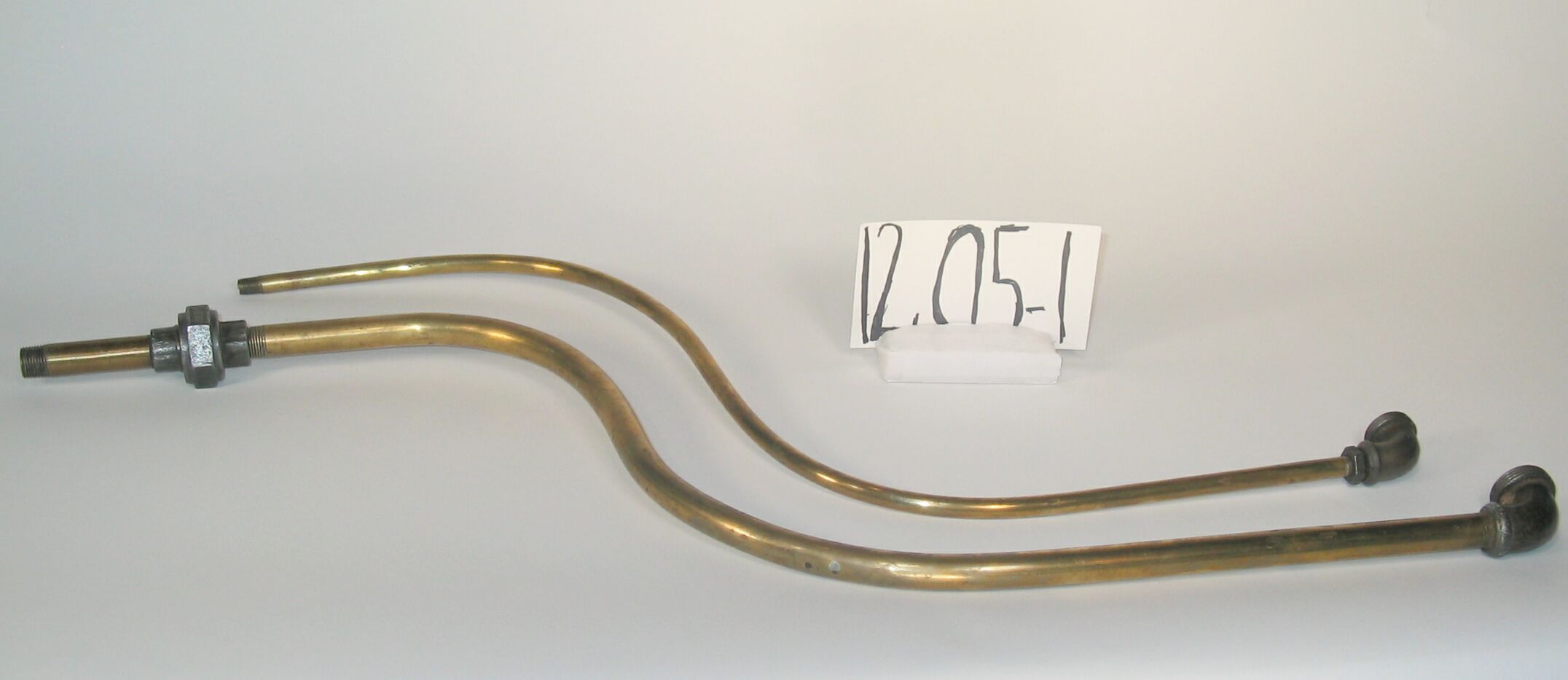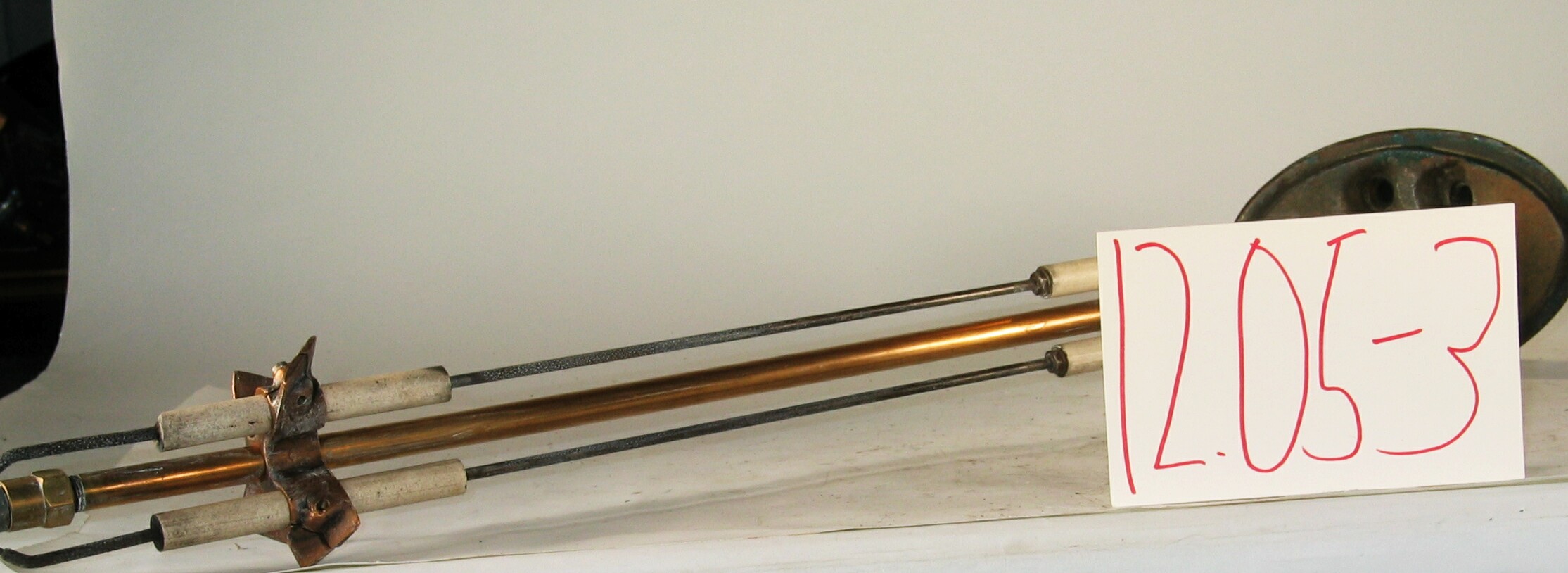12.05-1: Anaconda 1929 Oil Burner Piping Harness

| HHCC Accession No. 2006.135 | HHCC Classification Code: 12.05-1 |
|---|
Description:
Beautifully curved, shiny brass oil burner piping harness, with heavy wall, 3/8 inch suction and ‘ inch discharge lines, equipped with black wrought iron pipe fittings and Dart unions with brass seats. Such harness would stand as a kind of cultural marker of the times, reflecting the oil burner manufacture’s desire to allay public fears about quality and safety of this new technology being brought into the Canadian home in the 1920’s, Anaconda, Circa 1929:
Group:
12.05 Pressure Atomizing Oil Burner Equipment and Systems - Firing Assemblies
Make:
Anaconda
Manufacturer:
Anaconda
Model:
67
Serial No.:
Size:
3/8 and ‘ inch pipe lengths, 32 inch long
Weight:
3.5 lbs.
Circa:
1929
Rating:
Exhibit, education, and research quality, illustrating the application of brass in pipe and fitments for household automatic oil heating equipment in Canada in the 1920’s and 30’s.
Patent Date/Number:
Provenance:
From York County (York Region) Ontario, once a rich agricultural hinterlands, attracting early settlement in the last years of the 18th century. Located on the north slopes of the Oak Ridges Moraine, within 20 miles of Toronto, the County would also attract early ex-urban development, to be come a wealthy market place for the emerging household and consumer technologies of the early and mid 20th century.
This artifact was discovered in the 1950’s in the used stock of T. H. Oliver, Refrigeration and Electric Sales and Service, Aurora, Ontario, an early worker in the field of agricultural, industrial and consumer technology.
Used on an automatic oil heating system, in an estate home, in York County [York Region] north of Toronto
Type and Design:
3/8 and ‘ inch IPS brass pipe gracefully curved black malleable iron IPS fittings
Construction:
Material:
Special Features:
Accessories:
Capacities:
Performance Characteristics:
Operation:
Control and Regulation:
Targeted Market Segment:
Consumer Acceptance:
Merchandising:
Market Price:
Technological Significance:
Brass, because of its special properties [malleability and corrosion resistance] and the relative ease of manufacture, was a material of choice for much speciality manufacturing in the 1920-40’s, a period prior to the development of plastics, which over the next half century would replace brass in many applications. During these early years massive quantities of brass would be used in speciality manufacturing areas in fluid flow applications such as automatic oil heating and refrigeration. Here corrosion free operation, as well as appearance were important factors in engineering and the market place. [see for example ID#260 to 264]
Industrial Significance:
Socio-economic Significance:
Beyond its many engineering benefits [malleability and corrosion resistance] brass was the material of cultural choice in the early years of the 20th century. It was a cultural imperative, used effectively by the automatic oil heating industry to appeal to the up-scale market of the day dominated by Anglo-European settlement. For in the 1920’s it was largely the economic elite’s of the time that defined the market for automatic home heating. The Canadian public, those who could well afford laboursaving machines for the home, was plagued with feelings of uncertainty about contrivances such as automatic oil heating and the mechanical refrigerator. The concern was for their quality, safety and reliability. Manufacturers had a selling job to do, and knew it. They took every opportunity to demonstrate the quality, strength, durability and reliability of their home heating equipment - as well as its “good taste”.
Shinny brass pipe was a good place to start. Brass fitments in the home were the symbols of acknowledged good taste. From the front door knocker to the dinner table, and now to the basement furnace room, well tended brass stood for care and craftsmanship, highly valued by Canadian, Edwardian Society.
Socio-cultural Significance:
Donor:
G. Leslie Oliver, The T. H. Oliver HVACR Collection
HHCC Storage Location:
Tracking:
Bibliographic References:
Notes:
Related Reports:
CMX04 and CMX04 exhibits, item H3





